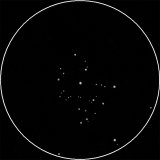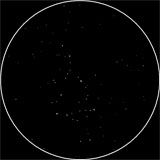
| MESSIER 39 |
|---|
RA: |
21h 32m 12s |
|
DEC: |
+48° 26' 00'' |
|
Type: |
Open Cluster |
|
NGC: |
7092 |
|
Magnitude: |
6.30 |
|
Surface brightness : |
||
Apparent dimensions : |
32'x32' |
|
Distance: |
825 ly |
|
Discovered by Charles Messier in 1764. M39 is a very large but very loose open cluster, situated some 9 degrees east and a bit north of Deneb (Alpha Cygni). Its distance is only about 800 light years, and it is of intermediate age (estimates between 230 and 300 million years). 30 stars are proven members and contained in a volume of about 7 light years diameter. Its apparent visual brightness of 4.6 magnitudes corresponds to an absolute magnitude of -2.5, or an intrinsic luminosity of 830 suns. This cluster is best observed with lowest powers because of its considerable angular size of 32 arc minutes, more than the Moon. Under good conditions, it can just be glimpsed with the unaided eye. It is well seen in opera glasses and smaller binoculars as a nebulous object, resolved in a 7x50, great at small powers, where its shape stands out: An equilateral triangle with a bright star at each corner, the southerly side aligned about East-West: a 9th mag star at its Northern corner, and one of 7th mag each at the SE and SW corners. About 25 fainter stars within. Many of its stars are grouped in pairs. The cluster is impressive and despites its looseness, well defined in and detached from a rich Milky Way star field. At higher magnifications it fills many fields and gets less impressive. M39 is not difficult to find: From Deneb (Alpha Cygni) first locate Rho Cygni, a star of 4th magnitude which is about 9 deg East, possibly via intermediate Zeta Cygni. M39 is 3 deg N and 1/4 deg W. It is also 2 1/2 deg W and 1 deg S of 4.5-mag Pi2 Cygni. |
||
Other sketches |
|||||
 |
|||||
Messier 39 (May 06). |
|||||
VEDRAN VRHOVAC© 2006.-2007. |
